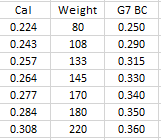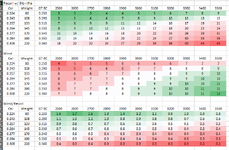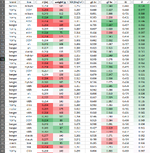solarshooter
WKR
I have shown some calcs in the past where I've done point assessments of certain cartridges/bullets/rifles to try and determine what is the lowest recoil way to get a certain wind number. Today I decided to elaborate on this a bit and assess recoil and wind number as a function of MV and caliber.
First, I created a reference bullet for each caliber which has a weight and BC representative of the highest performing bullets in that caliber.

I then estimated powder charges needed to get that bullet to the given MV in a roughly 20" barrel. This is cartridge agnostic, and may not be perfect. I use this in conjunction with bullet momentum to calculate total recoil.

I then calculate recoil in a 9lb rifle, run the bullet at the given speed to determine the wind number, and finally calculate wind# per recoil.

The way I would use this chart is to narrow in on what bullet at what speed gives you your desired performance and what the "recoil efficiency" of that combination would be. You could then pick your barrel length and cartridge to get you that performance target. For instance, if you ask what is the minimum recoil way to get an 8mph wind number gun, the answer is a 6mm bullet at 3200fps or so, aka a 6UM. It also shows you the recoil INefficiency of larger calibers - moving up in weight is almost always less recoil efficient than going faster.
First, I created a reference bullet for each caliber which has a weight and BC representative of the highest performing bullets in that caliber.

I then estimated powder charges needed to get that bullet to the given MV in a roughly 20" barrel. This is cartridge agnostic, and may not be perfect. I use this in conjunction with bullet momentum to calculate total recoil.

I then calculate recoil in a 9lb rifle, run the bullet at the given speed to determine the wind number, and finally calculate wind# per recoil.

The way I would use this chart is to narrow in on what bullet at what speed gives you your desired performance and what the "recoil efficiency" of that combination would be. You could then pick your barrel length and cartridge to get you that performance target. For instance, if you ask what is the minimum recoil way to get an 8mph wind number gun, the answer is a 6mm bullet at 3200fps or so, aka a 6UM. It also shows you the recoil INefficiency of larger calibers - moving up in weight is almost always less recoil efficient than going faster.


